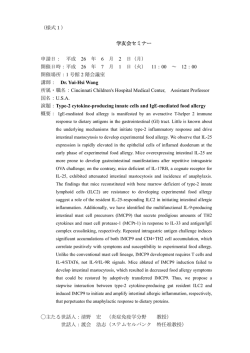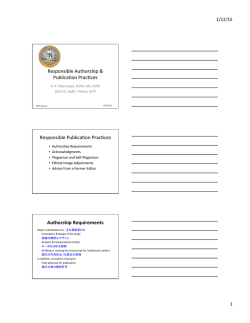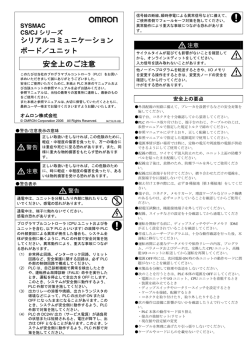
論文内容の要旨および審査結果
氏 名 ( 本 籍 ) 金丸 佳織(神奈川県) 学 位 の 種 類 博士(生命科学) 学 位 記 番 号 博 第87号 学位授与の日付 平成26年3月20日 学位授与の要件 学位規則第 5 条第 1 項該当 学 位 論 文 題 目 Epidermal phospholipase Cδ1 regulates granulocyte counts and systemic interleukin-17 levels 論 文 審 査 委 員 (主査) 深見 希代子 教授 田中 正人 教授 伊東 史子 准教授 松下 暢子 准教授 論文内容の要旨 Interleukin-17 (IL-17) exerts pleiotropic effects and is important in the pathogenesis of several diseases. This cytokine protects animals against several infectious diseases; however, it is also involved in the development and progression of autoimmune diseases such as multiple sclerosis, rheumatoid arthritis, psoriasis, and inflammatory bowel disease. IL-17 is mainly produced by T lymphocytes, and its production is regulated by IL-23. IL-17 induces granulocyte colony-stimulating factor (G-CSF), which is involved in granulopoiesis. Granulocytes play critical roles in the development of several inflammatory diseases. Because granulocytes have a short lifespan, continuous replacement and robust mechanisms to strictly regulate their numbers in the circulating blood are essential. IL-17-producing T lymphocytes play an important role in granulocyte homeostasis, and IL-17 overproduction by these cells causes granulocytosis. Granulocytosis is a common feature of several autoimmune diseases such as rheumatoid arthritis. Recently, it was reported that the hematopoietic loss of a phospholipase C (PLC) isozyme, PLCβ3, resulted in a remarkable increase in the number of granulocytes. PLC hydrolyzes phosphatidylinositol 4,5-bisphosphate to generate the second messengers inositol 1,4,5-trisphosphate and diacylglycerol (DAG), leading to an elevation in the concentration of intracellular calcium ions and activation of protein kinase C (PKC). A total of 13 PLC genes have been identified in mammals, among which, a PLC isozyme, PLCδ1, is abundantly expressed in the epidermis, the outermost layer of the skin. Keratinocytes are the major component of the epidermis. The epidermis has a stratified structure maintained by a polarized pattern of keratinocyte growth and differentiation. Keratinocytes not only act as a physical barrier to the external environment but also exert important immune functions by secreting a variety of cytokines that initiate inflammatory responses. Indeed, keratinocytes play critical roles in the development and progression of human inflammatory skin diseases such as psoriasis and atopic dermatitis. In this study, I discovered that mice lacking PLCδ1 showed spontaneous granulocytosis. Unexpectedly, granulocytosis was not caused by the loss of PLCδ1 in the hematopoietic compartment, but by the loss of PLCδ1 in the epidermal keratinocytes. Furthermore, epidermal ablation of PLCδ1 also resulted in local and/or systemic overproduction of IL-23, IL-17, and G-CSF, indicating that PLCδ1 in keratinocytes regulates the activation of the IL-23/IL-17 axis and granulocyte homeostasis. Results 1. PLCδ 1− /− mice show granulocytosis in a non-hematopoietic-cell intrinsic manner I found that mice lacking PLCδ1 (PLCδ1− /− mice) had twice the number of peripheral blood leukocytes than wild-type mice. Fluorescence-activated cell sorting (FACS) analysis revealed that the populations of CD11b+ Gr-1+ granulocytes were markedly increased in the peripheral blood leukocytes, spleen, and bone marrow of PLCδ1−/− mice. In addition, PLCδ1−/− mice had enlarged inguinal lymph nodes (ILNs) and spleens as compared to PLCδ1+/ − mice. Surprisingly, mice transplanted with PLCδ1−/− bone marrow cells had normal numbers of granulocytes and did not develop lymphadenopathy and splenomegaly. Thus, granulocytosis in PLCδ1−/− mice was not due to the loss of PLCδ1 in the hematopoietic system. 2. PLCδ 1−/− mice show local and systemic IL-17 upregulation Because IL-17 has been shown to be a critical cytokine for granulopoiesis, I examined whether the IL-17 levels were increased in PLCδ1−/− mice. In analysis, the serum IL-17 concentration was found to be elevated in PLCδ1−/− mice. In addition, the skin-draining LNs and skin of PLCδ1−/− mice showed IL-17 upregulation, suggesting that the skin plays a pivotal role in IL-17 overproduction in PLCδ1−/− mice. 3. Epidermal PLCδ1 is sufficient for normal IL-17 levels PLCδ1−/− mice carrying Foxn1::PLCδ1 (Tg/KO mice) were generated by reintroducing the PLCδ1 gene into keratinocytes of PLCδ1−/− mice. Interestingly, the skin of Tg/KO mice showed normal IL-17 expression. In addition, Tg/KO mice did not exhibit either serum IL-17 elevation or granulocytosis. These observations indicate that PLCδ1 expression in keratinocytes was sufficient for the maintenance of normal IL-17 levels and granulocyte counts as well as support our interpretation that the loss of PLCδ1 in keratinocytes leads to IL-17 upregulation and granulocytosis. 4. Epidermal PLCδ1 regulates the local and systemic IL-17 levels Keratinocyte-specific conditional PLCδ1-knockout (cKO) mice were created to examine whether loss of PLCδ1, specifically in keratinocytes, is sufficient for IL-17 upregulation and granulocytosis. Real-time RT-PCR detected IL-17 expression in the cKO skin, but not in the control skin. IL-17 upregulation was more evident in the epidermis than in the whole skin of cKO mice. IL-17 elevation was also observed in the skin-draining LNs and serum of cKO mice. In addition, cKO mice exhibited granulocytosis, consistent with local and serum IL-17 upregulation. These results indicate that the loss of PLCδ1 in keratinocytes is sufficient to cause IL-17 upregulation and granulocytosis. 5. Epidermal PLCδ1 regulates IL-23 expression in the skin IL-23 is an IL-17-inducing cytokine. Therefore, I examined IL-23p19 expression and found that its mRNA was upregulated in the skin of cKO mice. Interestingly, IL-17 and its key upstream regulator, IL-23, were upregulated in the epidermis of cKO mice. IL-23 neutralization with anti-IL-23p19 antibody decreased the IL-17 mRNA levels in the cKO epidermal sheet, indicating that IL-23 plays a critical role in IL-17 upregulation in the epidermis of cKO mice. 6. Activation of PLC downstream effectors ameliorates IL-23 overproduction I then investigated the mechanisms for IL-23 upregulation. Loss of PLCδ1 in keratinocytes resulted in a more than 90% decrease in the overall PLC activity in the epidermis, indicating that PLCδ1 is a dominant PLC isoform in the epidermis. The PKC activity was determined by examining the phosphorylation status of PKC substrates. Consistent with the decrease in the PLC activity, the amount of phosphorylated PKC substrates was also decreased in the cKO epidermis, indicating that the epidermal PLCδ1 is required for PKC activity in the epidermis. Then, I examined whether activation of PLC downstream signals restores normal IL-23p19 expression. Therefore, I treated epidermal sheets from control and cKO mice with ionomycin, a calcium ionophore, and phorbol 12-myristate 13-acetate (PMA), a synthetic analogue of DAG and a PKC activator, to mimic PLC activation. Treatment with ionomycin and PMA did not alter IL-23p19 expression in the control epidermal sheet, but decreased it in the cKO epidermal sheet. These results suggest that impaired activation of PLC downstream signals contributes to IL-23 upregulation in the cKO epidermis. 7. Keratinocyte-specific PLCδ 1− /− mice show features of human psoriasis As IL-23 and IL-17 are upregulated in the skin of patients with psoriasis, PLCδ1 could be involved in the development and/or progression of psoriasis. Interestingly, PLCδ1 protein is decreased in the epidermis of the human psoriatic skin and murine psoriatic skin. In addition, the cKO skin showed epidermal hyperplasia and immune cell infiltration similar to the skin of psoriasis patients. Real-time RT-PCR showed that psoriasis-related inflammatory genes were also upregulated in the cKO skin. Thus, the cKO skin shows some characteristics of human skin diseases such as psoriasis. 8. PLCδ1 in keratinocytes influences contact hypersensitivity To investigate the physiological or pathological significance of IL-17 elevation in cKO mice, I examined hapten-induced contact hypersensitivity (CHS) responses, in which IL-17 plays critical roles. Mice were sensitized and challenged with dinitrofluorobenzene (DNFB), and the CHS response was determined by measuring the extent of ear swelling. Ear swellings of cKO mice were 2.4-, 2.0-, 2.1-, and 2.9-fold increased as compared with those of control mice at 24, 48, 72, and 96 h after challenge, respectively. cKO mice did not exhibit increased ear swelling when IL-17 was neutralized by an anti-IL-17 antibody, indicating that the exaggeration of CHS responses in cKO mice was IL-17-dependent. Conclusion In this study, I demonstrated that keratinocyte dysregulation by PLCδ1 deletion results in aberrant activation of the IL-23/IL-17 axis and granulocytosis (figure). These findings suggest the clinical potentials of targeting body surface-specific inflammatory pathways for the prevention of granulocytosis and IL-17-related disorders. Figure Proposed model of local and systemic phenotypes induced by epidermal loss of PLCδ1. Publications Publication of the doctoral thesis Kaori Kanemaru, Yoshikazu Nakamura, Kojiro Sato, Ryota Kojima, Saori Takahashi, Mami Yamaguchi, Manabu Ichinohe, Hiroshi Kiyonari, Go Shioi, Kenji Kabashima, Kyoko Nakahigashi, Masataka Asagiri, Colin Jamora, Hideki Yamaguchi, and Kiyoko Fukami (2012) Epidermal phospholipase C δ1 regulates granulocyte counts and systemic interleukin-17 levels in mice. Nat. Commun. 3, Article number: 963. DOI: 10.1038/ncomms1960 Other publications 1. Kaori Kanemaru, Masamichi Nakahara, Yoshikazu Nakamura, Yoko Hashiguchi, Zen Kouchi, Hideki Yamaguchi, Naoko Oshima, Hiroshi Kiyonari, and Kiyoko Fukami (2010) Phospholipase C-eta2 is highly expressed in the habenula and retina. Gene Expr. Patterns. Feb-Mar;10(2-3):119-26 2. Kiyoko Fukami, Shunichi Inanobe, Kaori Kanemaru, and Yoshikazu Nakamura (2010) Phospholipase C is a key enzyme regulating intracellular calcium and modulating the phosphoinositide balance. Prog. Lipid Res. 49:429-437. 3. Yoshikazu Nakamura, Kaori Kanemaru, and Kiyoko Fukami (2013) Physiological functions of phospholipase Cδ1 and phospholipase Cδ3. Adv Biol Regul. 53: 356–362. 審査の結果の要旨 イノシトールリン脂質代謝酵素の一つであるホスホリパーゼ C (PLC) はセカンドメ ッセンジャーの産生を介して様々な細胞応答を引き起こす重要な酵素である。PLC の一つである PLCδ1 の遺伝子欠損マウスにおいて全身性の顆粒球増加が観察された ことから、その機構解明を目的に研究を行った。 学位申請者は、PLCδ1KO マウスで見られた顆粒球増加の原因が造血細胞における PLCδ1 の欠損に起因するのではないかと考え、まず野生型マウスに PLCδ1KO マウ ス由来の骨髄細胞を移植したが、顆粒球増加は観察されず、造血細胞の異常に起因し ないことが判明した。そこで PLCδ1KO マウスの示す顆粒球増加に、遠隔組織由来の 液性因子が関与する可能性を考え、顆粒球増加を引き起こすサイトカインである IL-17 に着目したところ、PLCδ1KO マウス血中で IL-17 の濃度上昇が認められた。 また IL-17 産生細胞が PLCδ1KO マウスの皮膚所属リンパ節及び皮膚で増加している ことを明らかにした。これらのことは皮膚での PLCδ1 の欠損が顆粒球増加や IL-17 産生亢進の原因であると考えられた。 そこで次に表皮特異的に PLCδ1 の発現を回復させた PLCδ1KO マウスを用いたと ころ、IL-17 産生量や顆粒球数が正常レベルに回復することが判明した。逆に表皮特 異的 PLCδ1 欠損マウス (cKO マウス) を用いると、全身の IL-17 の増加や顆粒球増 加が引き起こされた。さらに cKO マウス皮膚では IL-23 の発現が増加しており、cKO マウス皮膚での IL-17 の産生増加は IL-23 の増加に依存することを見出した。また、 皮膚における IL-23 産生細胞はケラチノサイトであり、IL-17 産生細胞は表皮常在性 の T 細胞であることも判明した。次に、PLCδ1 の欠損による IL-23 産生増加機構の 検討を行ったところ、PLCδ1 の欠損により表皮の全 PLC 活性及びプロテインキナー ゼ C (PKC) 活性が低下しており、 PKC 活性化剤 PMA とイオノマイシン処理により、 IL-23 の産生量が正常値まで減少した。これらの結果より表皮 PLCδ1 の欠損は、PLC 活性及びその下流シグナルの活性低下を介し、表皮での IL-23 産生増加、表皮常在性 T 細胞からの IL-17 産生を誘導し、全身での IL-17 や顆粒球の増加を引き起こしてい ることが明らかになった。更に皮膚における IL-23、IL-17 産生増加はヒト乾癬にお いて見られるが、cKO マウスの皮膚においても乾癬様皮膚炎症が観察された。実際の 乾癬患者表皮においても PLCδ1 の発現低下が観察され、PLCδ1 が乾癬の発症に関与 している可能性が示唆された。 本研究の結果より表皮特異的なイノシトールリン脂質代謝の乱れが局所の炎症のみ ならず血中のサイトカイン量の調節を介して全身の顆粒球増加を引き起こすことが 明らかとなり、今後表皮をターゲットにした全身性疾患の治療に繋がり得る可能性が 考えられる。 学位申請者は、これらの結果を Nat. Commun. 3, 963 (2012) に第一著者として報 告しており、学術的成果は充分である。従って本申請論文は博士学位論文に値すると 判断する。
© Copyright 2026


